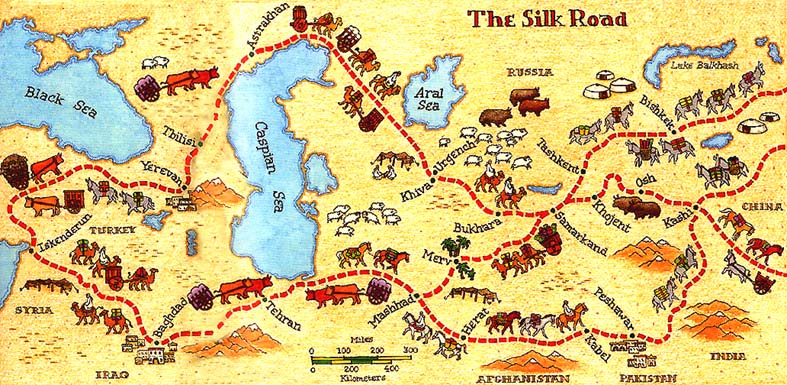With the arrival of the first Chinese in the mid 2nd
century Bñ, Samarkand entered an era of invasion-proof prosperity
and semi-mythic international status. It was to last more than a thousand
years and it began because the Chinese found that silk, which they alone
knew how to make, was worth more than its weight in gold in the empires
of the West.
Samarkand was at the very center of the Silk Route system.
The only Chinese caravans which did not pass through it were those heading
straight for Russia from the passes of the Tien Shan-and Russia was but
a minor client until of Kiev rose to power and prosperity in the 9th century.

Considering the volume of through traffic, remarkably
little is known about life in ancient Samarkand. Archaeologists are hampered
by the wind; before Tamerlane the city was built mostly of mud, so that
over the centuries buildings simply dried up and blew away. And Asian caravans
do not seem to have kept diaries. So we have an account by Arrian, Alexander's
chronicler, and then nothing until 1200 years later when the Arabian traveler
Abulkasim ibn-Khakal was much taken by Samarkand's canals. Marco Polo's
Travels kept alive the legend of Samarkand for Europeans, even if he never
actually went there. Thereafter Europeans arrived at the rate of about
one every hundred years until the 1860s. In the end the rarity of writings
about Samarkand is eloquent confirmation of its extreme isolation; until
1868 it was still, in Geoffrey Moorhouse's words, 'a great deal more remote
from the rest of civilization than the moon is today.'
At least we know that when those first Chinese arrived,
Samarkand was part of the (Persian) Achaememd empire, and that, like the
rest of Transoxiana, it passed to Kushans, Hephthalites and Turks before
the coming of the Arabs. From bowls and fire-proof altars in Afrasiab's
museum it also seems that the potting wheel arrived on the scene in the
lst century ad and that the prevailing religion was Zoroastrianism, or
fire-worship.
The secrets of silk making reached the West in the 6th
century and the flow of Chinese silk through Samarkand gradually diminished
as Italy, Spain and southern France began making their own. But Samarkand
was to remain a crossroads of international trade in other commodities
until sea routes were established between Europe and the Orient in the
16th century.
[back]
|
